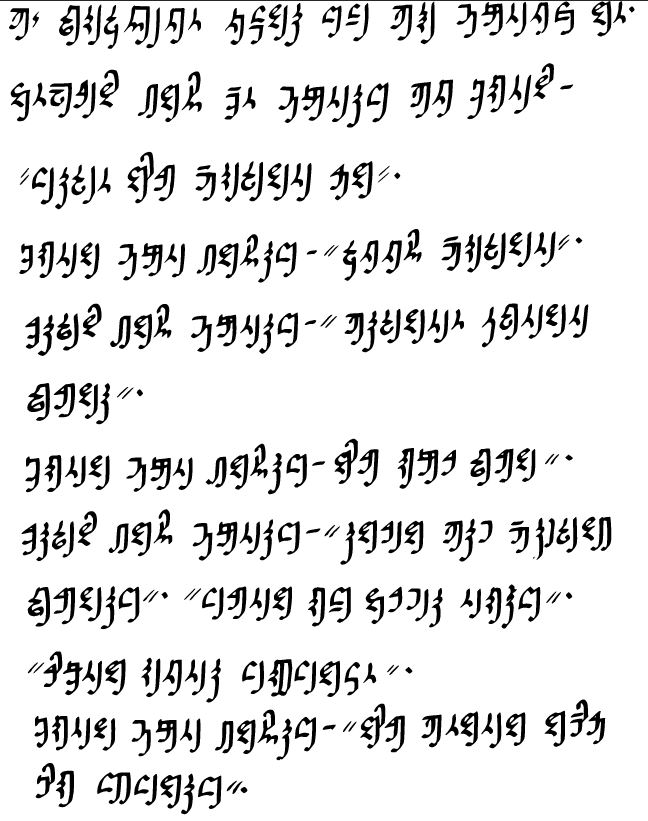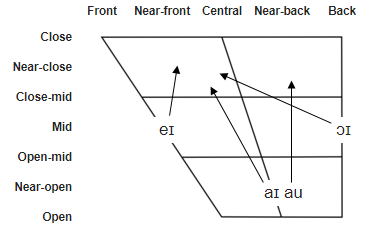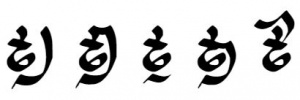Lortho
| Lortho ['loɾ.tʰo] | |
| Spoken in: | Dhamashi |
| Conworld: | A circumbinary planet |
| Total Speakers: | 6 million |
| Genealogical classification: | Proto-Lamona - Old Lortho - Lortho - ? |
| Basic word order: | Verb-Subject-Object |
| Morphological Type: | Agglutinating |
| Morphosyntactic Alignment: | Nominative-Accusative |
| ISO 639-3 Code: | qlt |
| Created by: | |
| Brian Bourque | Conceived in 2003, Manifested in 2017 |
Lortho is an a priori constructed language created by Brian Bourque in the beginning of 2003. It originally started as a prop for a strategy board game where only the script was created for aesthetics. It is an agglutinating language with some minor fusional aspects.
The people (Kalanune) who speak Lortho live on Dhamashi, a circumbinary plant which has two natural satellites. The planet's surface has many similarities to Earth where it has oceans, mountains, deserts, and forests. The planet has three major continents: Mashonu, Kashti, and Lamona. The Kalanune live on Lamona.
Inspiration
A friend was creating a board game similar to Risk; however, instead of taking place on Earth, this new game was to take place on an inter-planetary scale. The game creator wanted to develop an extraterrestrial theme and requested a fictional script[1]. The name of the race on this game is "Lortho" (IPA: [ˈloɹ.θo]) and thus the seed was planted. I was unable to work on this piece for quite sometime until I joined the CONLANG mailing list[2] and observed both seasoned and novice conlangers discussing all aspects of linguistics. Since then I decided to move forward and bring Lortho into fruition. The language itself was not invented until the spring of 2016.
Much of the language stems from the languages that I know, namely Persian, French, and Korean. Although the language is a priori, much of its construction resembles that of an Indo-European flavor; albeit unintentionally. The phonology is largely inspired by Persian (Farsi) in that each letter is strictly pronounced regardless of their position in the the syllable/word. The agglutinating aspect of the language was largely influenced by Korean; however, the cases were inspired by both Hungarian and Finnish. The orthography was inspired by Central/East Asian orthographies which is further expounded here.
Another source of inspiration is my daughter. Through her development of learning how to make speech sounds leading to coherent speech and communication, she "created" words to communicate her wants and needs. Some of these words found their way into the Lortho lexicon.
Why?
Many people have asked me, "Why? What is the goal?" The answer is fairly straightforward: I am an artist and I love languages. So, I merged the two. I have an affinity towards non-Latin writing systems and I truly enjoy calligraphy. Therefore, aesthetics are very important in Lortho. If I am honest with myself, I would love to see this language in a movie or television series, but that isn't the main goal. The goal is to make a functional language and its associated world to where I can create works of art pertaining to this world/culture. I want to instill a sense of awe and wonder as if an old relic of eons past had been discovered and its beauty is unsurpassed by anything compared to contemporary times.
Phonology
Consonants
| Bilabial | Labiodental | Alveolar | Postalveolar | Velar | Glottal | |||||||
|---|---|---|---|---|---|---|---|---|---|---|---|---|
| Plosive | p pʰ | b | t tʰ | d dʰ | k kʰ | |||||||
| Nasal | m | n | ||||||||||
| Tap or Flap | ɾ | |||||||||||
| Fricative | f | s | ʃ | h | ||||||||
| Lateral Approximant | l lʰ | |||||||||||
Vowels
Monophthongs
There are five vowels in Lortho which are strictly pronounced regardless of placement or stress.
| Front | Near- front | Central | Near- back | Back | ||
| Close | 
| |||||
| Near-close | ||||||
| Close-mid | ||||||
| Mid | ||||||
| Open-mid | ||||||
| Near-open | ||||||
| Open | ||||||
Diphthongs
Syllable Structure
The syllable structure is (C)V(V)(C).
Romanization System
For ease of reading outside of its script, a system of Romanization has been developed as shown in the tables below.
| Consonants | ||||||||||||||||||||
| IPA | dʰ | d | kʰ | k | lʰ | l | tʰ | t | pʰ | p | ʃ | s | n | nː | m | mː | h | b | f | ɾ |
| Romanization | dh | d | kh | k | lh | l | th | t | ph | p | sh | s | n | nn | m | mm | h | b | f | r |
| Monophthongs | ||||||
| IPA | i | ɑ | ɛ | o | u | |
| Romanization | i | a | e | o | u | |
| Diphthongs | ||||
| IPA | aɪ | eɪ | aʊ | ɔɪ |
| Romanization | ai | ei | au | oi |
Orthography
Writing System
The writing system of Lortho is called Dhadakha, so named from the first three letters. It is an alphabet with some featural aspects in denoting aspirated vs tenuis consonants. Dhadakha is comprised of 21 letters, one of which is a vowel. The writing system has some qualities reminiscent of an abugida; however, there are no conjunct consonants and vowels are given equal status as consonants. Ligatures are formed by consonant + vowel with the vowels [i] and [ɛ] being the exceptions. Lortho's script was inspired by the Devanagari, Uchen, and Tengwar writing systems.
| UPDATE: |
| This script has been revised to include a "common" script. More to come. |
Vowels
The vowels are written as ligatures:
| [dʰi] | [dʰa] | [dʰɛ] | [dʰo] | [dʰu] |
| Lortho vowels (bookish) | ||||
| [dʰa] | [dʰɛ] | [dʰo] | [dʰu] | [dʰi] | [dʰ] |
| Lortho vowels (simplified) | |||||
Grammar
Nouns
Lortho has ten cases. The following word will be used for demonstration:
- kansaptha
(n. neut.)
- forest, woods
| Case | Modifier | Example | English |
|---|---|---|---|
| Nominative | - | kansaptha | forest, woods |
| Accusative | -me | kansapthame | forest (direct obj.) |
| Dative | -mela | kansapthamela | forest (indirect obj.) |
| Genitive1 | -nau | kansapthanau | of the forest |
| Lative | -ina/ena | kansapthaina | in/into the forest |
| Ablative | -nat | kansapthanat | out of (from) the forest |
| Allative | -dan | kansapthadan | to/towards the forest |
| Prolative | -dar | kansapthadar | through the forest |
| Instrumental | -len | thomidin kansapthalen | I live off of the forest |
| Vocative2 | fa(l)- | fakansaptha, lharid! | Run, forest! |
1 -nau is the alienable genitive whereas -tho is the inalienable genitive.
2 the vocative case is the only case which forces the word order to change to SVO vs. the normal VSO.
Possessives
The possessives are formed by using personal prefixes to the nouns. The same word kansaptha will be used in the table below.
| Person | Singular | Plural | ||||
|---|---|---|---|---|---|---|
| masc | fem | neut | masc | fem | neut | |
| 1st person | nikansaptha | nukansaptha | - | nimakansaptha | numakansaptha | - |
| 2nd person | linkansaptha | lunkansaptha | - | nanikansaptha | nanukansaptha | - |
| 3rd person | likansaptha | lukansaptha | lakansaptha | limikansaptha | limukansaptha | limakansaptha |
Gender and Number Agreement
There are three rules for noun-adjective-verb agreement:
- Verbs must match number and gender of the noun.
- Adjectives must match noun gender, but not number or grammatical case.
- When a specific noun is counted, the noun does not take the plural since the ordinal number denotes pluralization.
Examples
| English | Lortho |
|---|---|
| We walk through their forest | malhirinan limakansapthadar |
| He sat on his chair | shailanikhi lidhammoina |
Verbs
There are three major verb types: -o verbs, -t verbs, and -n verbs. Each follow a general rule for conjugation.
-o verbs
-o verbs are conjugated by subtracting the -o and adding the personal endings.
-t verbs
-t verbs are conjugated by changing the -t to -d then adding the personal endings
-n verbs
-n verbs keep their infinitive form and personal endings are simply added to the verb. The exception to this rule is the verb [hɑɾlɑn] to be, which will be discussed later.
Conjugation Table
| Present Tense | |||||
|---|---|---|---|---|---|
| -o Verbs konpharo [kon.'pʰɑ.ɾo] to speak root: konphar- |
-t Verbs phramit ['pʰɾɑ.mit] to push root: phramid- |
-n Verbs shailan [ʃɑɪ.'lɑn] to sit root: shailan- | |||
| konpharin, konpharun | konpharinan, konpharunan | phramidin, phramidun | phramidinan, phramidunan | shailanin, shailanun | shailaninan, shailanunan |
| konpharanni, konpharannu | konpharamin, konpharamun | phramidanni, phramidannu | phramidamin, phramidamun | shailananni, shailanannu | shailanamin, shailanamun |
| konphari, konpharu, konphara | konpharimi, konpharimu, konpharima | phramidi, phramiu, phramia | phramidimi, phramidimu, phramidima | shailani, shailanu, shailana | shailanimi, shailanimu, shailanima |
Irregular Verbs
At present, there are very few irregular verbs in Lortho; however, the irregular verbs which do exist are somewhat regular in their own right. One such verb is harlan to be.
The verb harlan is conjugated slightly different from the regular -n verbs. The -an is dropped and then the personal endings are added to the root, harl-.
| harlan [hɑɾlɑn] to be root: harl- | ||||||
|---|---|---|---|---|---|---|
| Singular | Plural | |||||
| masc | fem | neut | masc | fem | neut | |
| 1st person | harlin | harlun | - | harlinan | harlunan | - |
| 2nd person | harlanni | harlannu | - | harlamin | harlamun | - |
| 3rd person | harli | harlu | harla | harlimi | harlimu | harlima |
Passive Voice
The passive voice is formed by adding the suffix -im after the root before any other additional suffixes. The passive voice does not apply to the present tense.
Example:
- madhit (madhid-) v. to give
madhid-ikh-i i khanishu-me u -melagive -PST-3MSG PN.3MSG book.F -ACC PN.3FSG-DAT
He gave the book to her- In this example, the verb agrees with the subject he (i).
madhid-im -ikh-u khanishu-me u -melagive -PASS-PST-3FSG book.F -ACC PN.3FSG-DAT
The book was given to her- In this example, the verb agrees with book since there is no subject initiating the action.
Moods
Imperative
The imperative form of the verb is simply the root with the vocative case (which can be either implied or explicit).
Examples:
- famannu, konphar!
- Hey you, speak!
- fanamin, nathar namineme!
- Hey you, be quiet! (lit. quiet yourselves)
- fabrian, shailan!
- Brian, sit!
Vocabulary:
- konpharo (konphar-) v. to speak
- natharo (nathar-) v. to quell, pacify
- mannu pronoun you (fem. sing.)
- namin pronoun you (masc. pl.)
- shailan (shailan-) v. to sit
Sample Text
| Text | Translation |
| konpharin lorthome | I speak Lortho |

|
| Sample text in Lortho script. Text taken from Relay 24 in CALS |
Folklore
| The Unlucky Fox |

|
| Romanization:
shadar lharane dasat dharakhinat harlikhi nuphi. |
| IPA:
ˈʃɑ.dɑɾ lhɑ.ˈɾɑ.nɛ ˈdɑ.sɑt dʰɑ.ˈɾɑ.kʰi.nɑt ˈhɑɾ.li.kʰi ˈnu.pʰi |
Leipzid Gloss:
shadar lhara-ne dasat dharakhi -nat harl-ikh-i nuphi ago.ADV year -PL beyond.ADV mountain.M-ABL be -PST-3MSG fox.M Once upon a time, there was the fox khabal-ikh-i nuphi dalhota-me -khon dha-harl-ikh-a halhadar a search-PST-3MSG fox.M food.N -ACC-but NEG-be -PST-3NSG much.ADJ PN.3NSG The fox searched for food, but there was not much of it kilikh-ikh-i ikhi molha kansapu-me see -PST-3MSG one huge-N tree.N -ACC It saw a huge tree harl-ikh-a dir -dhalam-a li -dalhota mo -kansapo-ina be -PST-3NSG SUPERL -good -N PN.POSS.3MSG-food.N that -tree.F -SUBL Its favorite food was in that tree khar khes -ikh-i nuphi kansapu-me denal-ikh-u kansapu lu -khothu-me hana tushad-ikh-u khashu-me nuphi-nalo when scratch-PST-3MSG fox.M tree.F -ACC close-PST-3FSG tree.F PN.POSS.3FSG-wall.F-ACC and bury -PST-3FSG head.F-ACC fox.M-GEN When the fox scratched the tree, the tree closed its wall (here it means bark) and buried (trapped) the fox's head thar-ikh-u bonhan mon -u saurammu thasa -me nuphi-nalo eat -PST-3FSG twenty other-F animal.F head.N-ACC fox.M-GEN Twenty other animals ate the fox's body |
| I know this story is a little morbid; however, I was compelled to write a backstory as to why in Lorthoan culture calling someone a "fox" is considered derogatory, as in someone who is utterly unlucky. The story was partly inspired by the competition on the Conlang subreddit for reaching 20,000 followers and the theme was the numeral 20. |
Resources
Lortho
Lortho on CALS
Lortho in the 24th Conlang Relay
Lortho on ConWorkShop
Lortho Lexicon
Lortho on Linguifex
Lortho on Miraheze.org
The World of Damashi
Lortho - Hosted by LCS (new)
Conlangs
Conlang Atlas of Language Structures (CALS)
Conlang Bulletin Board (CBB)
Conlang Critic - a YouTube vlogger who offers insights on conlangs
Conlang Mailing List
Conlang Relay Museum on CALS
ConWorkShop - an online one-stop-shop for cataloging your conlang
Fiat Lingua - an online archive of conlang articles
Language Creation Society
LCS on YouTube
Reddit: Conlangs
Reddit: Neography (Constructed Scripts)
Speculative Grammarian - A satirical periodical about linguistics and conlangery
Zompist Bulletin Board (ZBB)
Linguistics
Endangered Alphabets - a not-for-profit organization to catalog 14 alphabets threatened by extinction
Glossika Phonics - a YouTube channel for IPA pronunciation
International Phonetic Alphabet
NativLang
Omniglot
Online Etymology Dictionary (English)
Reddit:Linguistics
Wikitongues
World Atlas of Language Structures (WALS)
"Truth is stranger than fiction, but it is because Fiction is obliged to stick to possibilities; Truth isn't." - Mark Twain Brian Bourque (talk) 17:15, 18 March 2017 (PDT)




